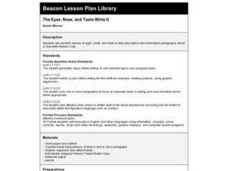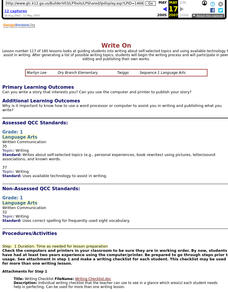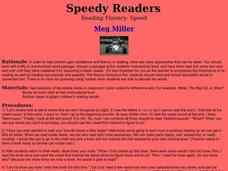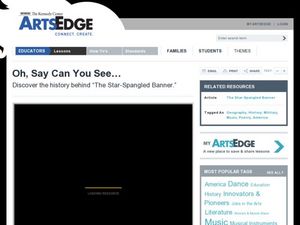Curated OER
Olly at the Doctor
Students recognize the short vowel "O" in written and spoken language. Through matching activities, they discriminate the short vowel /o/ from other vowel sounds. Students associate the phoneme with its letter representation and identify...
Curated OER
Musical Chairs Review Lesson Plan
Students review material by playing musical chairs. They identify shapes, colors and vocabulary. They give the definition of the new vocabulary words while playing the game as well.
Curated OER
Aaah, I'm hungry
First graders recognize the short vowel a in written and spoken language. Through matching activities, they discriminate the short vowel /a/ from other phonemes. Students associate the phoneme with its letter representation and spell...
Curated OER
The Eyes, Nose, and Taste Write It
Third graders generate a list of adjectives about a Reese's Cup using their sense of sight, touch, and taste. Then they write a descriptive paragraph about the Reese's Cup.
Curated OER
Beginning Reading Lesson: Aaa-aaa-aaa-choo!!
Pupils study the letter sound recognition for the /a/ by recognizing the sound one makes when they sneeze. They use a chart with a tongue twister on it and work with letterboxes and manipulative letters that focus on words with the /a/....
Curated OER
Spinning Short Vowel Game
First graders, in pairs, use spinners to experiment with different combinations of letters. They combine letters and determine whether they have produced a word or not. They construct and record words choosing letters from designated tiles.
Curated OER
Mmmm, Good!
Students complete a variety of activities related to the letter M. They trace and write the letter M, and identify words on word cards that contain the letter M. Students also participate in a Letter M Hunt in their classroom, and...
Curated OER
Lucky Ducky
First graders recognize the short vowel u in written and spoken language. Through matching and listening activities, they discriminate the short vowel /u/ from other phonemes. Students associate the phoneme with its letter representation...
Curated OER
Write On
First graders, after generating a list of possible writing topics, begin the writing process and participate in peer-editing and publishing their own works.
Curated OER
Great Gullah Story Telling Packet
Sixth graders examine the Creole language known as Gullah which is a form of speech comprised of a number of unrelated languages. They determine how slaves used this to communicate so that slave masters would not be able to understand...
Curated OER
Speedy Readers
Students read orally to increase their reading speed and fluency in this lesson. They listen to the teacher model expressive and fluent reading. They then practice reading orally with a partner. The partner times their reading with...
Curated OER
Speedy Readers
Student increase their reading fluency through the use of various strategies. After reviewing chunking, decoding, and rereading, students complete an initial read of a novel text. Working with a partner, they read complete a timed...
Curated OER
Writing About a Christmas Day Celebration
Students write about a Christmas Day Celebration they have experienced. In this personal narrative lesson, students use descriptive words to tell a story about their own family's Christmas. Students organize plot and develop the story as...
Curated OER
Letter T
In this letter t worksheet, student find and circle the letter in 3 simple words next to their pictures. There is one example given at the top.
Curated OER
Above and Below
In this above/below worksheet, students color shapes that are above or below other shapes, as indicated. A reference web site link in given.
Curated OER
Feathers, Flippers and Feet
Second graders read, "Feathers, Flippers and Feet." In groups, they research important information about feathers and wings. They discover why feathers and wings are important to animals. Students create a presentation to share with the...
Curated OER
Growing Seeds
In this science worksheet, students read 5 different scenarios with varied growing conditions for plants. Students make a prediction for each: Will it grow a little, grow a lot, or not grow at all?
Curated OER
Parts of a Crinoid
Students study the parts of a crinoid. In this parts of a crinoid lesson, students look at pictures of a crinoid fossil or examine an actual fossil if one is available. They match names to pictures of the parts in the second part of the...
The New York Times
Big Brother vs. Little Brother: Updating Orwell's 1984
Government surveillance is an enduring conflict that has become increasingly complex with our nation's use of technology. Add to the understanding of Orwell’s 1984 by using the resources here that display the contemporary actions of Big...
Curated OER
Oh, Say Can You See
Learners explore different parts of the eye and functions of each part through a video and a dissection of a cow's eye. They discover different causes of blindness.
Curated OER
Make Sense of Nature
Students participate in this program that heightens their awareness and curiosity of nature as well as their sense of adventure and exploring new surroundings. They identify and choose an object from nature after exploring it with other...
Curated OER
Sensing Somethong
Students are taught that they can gather information about objects using the five senses of vision, touch, smell, taste, and hearing. They are told that some sensing, like sight, is done remotely. Students observe how a camera can...
Curated OER
Mrs. Moore's Question
Fifth graders answer a fictitious question asked by their school principal. After reading the question together, they write an appropriate response and show her what they have gathered about the circulatory system. They type their letter...
Curated OER
Virtual Trip of Brazil
Sixth graders develop an annotated list of sights to visit in Brazil including a description of what to see and do there. They name and locate cities within Brazil. They place textual and graphic information on the web.

























